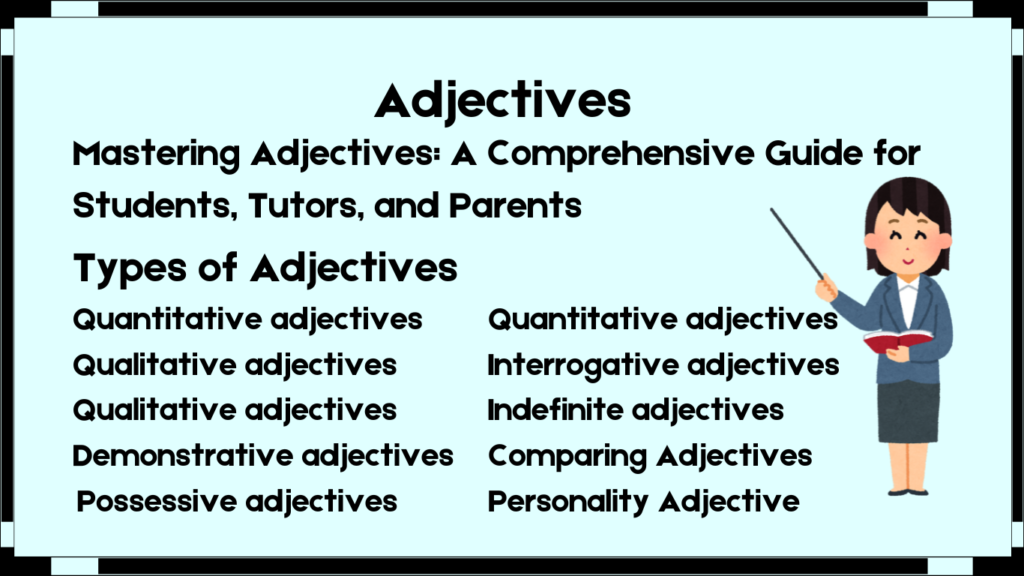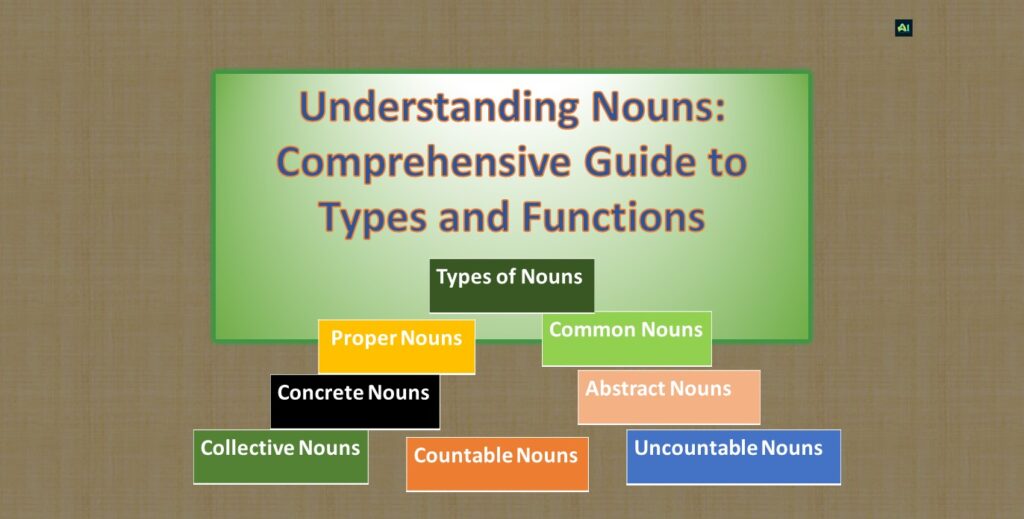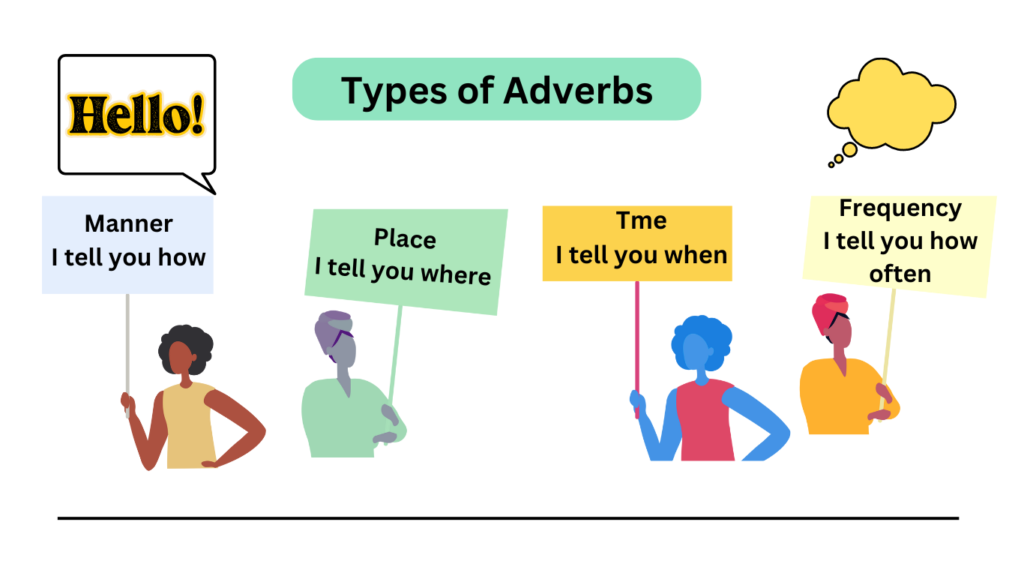Understanding Types, Comparisons, and Personality Adjectives to Enhance Your Language Skills
Mastering adjectives is not an option in English Language; It is a necessary part of mastering English. Adjectives are important words in our language because they help us describe things and people better. They make our sentences more interesting and help us express our thoughts and feelings. In this article, we’ll explore adjectives in detail, looking at different types, how we compare them, and what makes them special. Whether you’re a student, teacher, or someone who takes care of others, this guide will help you understand adjectives better so you can improve how you talk and write.
What are Adjectives?
Adjectives are words that describe or modify nouns or pronouns, indicating their qualities, properties, or characteristics. They basically answer questions like “What kind?”, “How many?”, or “Which one?” about the noun or pronoun they modify. Adjectives can be used to describe various aspects of a noun or pronoun, such as its size, shape, color, temperature, or personality.
Types of Adjectives
Adjectives fall into various categories, such as:
– Quantitative adjectives
What are Quantitative Adjectives?
Quantitative adjectives are words used to describe the quantity or number of a noun. They answer the question “How many?” or “How much?” and give precise information about the quantity or amount or degree of the noun being referred to. Unlike qualitative adjectives, which describe qualities or characteristics of nouns, quantitative adjectives focus on numerical values. (e.g., one, two, three)
How do Quantitative Adjectives Function?
Quantitative adjectives can be used in various ways within a sentence. They can precede the noun they modify or appear after a linking verb such as “is,” “are,” “was,” or “were.” The placement of quantitative adjectives depends on the sentence structure and the emphasis the speaker or writer intends to convey.
Examples of Quantitative Adjectives:
- “Three” in “three apples”
- “Many” in “many books”
- “Several” in “several options”
- “Few” in “a few friends”
- “Each” in “each student”
- “Half” in “half a cup”
- “All” in “all the students”
- “Both” in “both hands”
- “Several” in “several opportunities”
- “Enough” in “enough time”
Understanding quantitative adjectives can really help you make your writing and speaking clearer and more precise. When you use these adjectives well, you can tell your audience exactly how much or how many you’re talking about, which makes it easier for them to understand you.
Tips for Using Quantitative Adjectives:
- Be precise: Choose quantitative adjectives that accurately reflect the quantity or number you want to convey.
- Consider context: The appropriate quantitative adjective may vary depending on the context of your sentence. Consider the broader meaning and tone of your communication.
- . Use variety: Expand your vocabulary of quantitative adjectives to add depth and variety to your writing
- Check agreement: Ensure that quantitative adjectives agree in number with the nouns they modify. For example, “many bags” (plural) versus “much water” (singular).
– Qualitative adjectives(e.g., happy, tall, blue)
Qualitative adjectives help us to describe the quality or attributes of a noun. These adjectives provide more information about the noun they are referring to, helping to paint a clearer picture in the reader’s mind. Qualitative adjectives can describe things like size, color, shape, texture, and other attributes that help to define and distinguish the noun. By using qualitative adjectives effectively, writers can create more vivid and engaging descriptions that bring their writing to life.
In the sentences below you will find some examples of quantitative adjectives.
- The blue sky stretched endlessly above us.
- In this sentence, “blue” describes the quality of the sky, indicating its color.
- She donned a stunning dress for the party.
- Here, “stunning” describes the quality of the dress, indicating its attractiveness.
- The old buildings have been marked for demolition..
- In this sentence, “old” tells the quality of the buildings, indicating their age.
- His friendly demeanor made everyone feel welcome.
- Here, “friendly” describes the quality of his demeanor, indicating his behavior towards others.
- The delightful aroma of fried rice welcomed the guests.
- In this sentence, “delightful” describes the quality of the aroma, indicating its pleasing taste or smell.
- They were thrilled by the marvelous display of fireworks.
- Here, “marvelous” describes the quality of the display, indicating its ability to evoke admiration or awe.
- The eloquent speaker won the attention of his audience effortlessly. .
- In this sentence, “eloquent” describes the quality of the speaker, indicating his fluency.
- Her elegant handwriting flowed gracefully across the page.
- Here, “elegant” describes the quality of her handwriting, indicating its graceful and refined appearance.
- The intelligent student always excelled in her studies.
- In this sentence, “intelligent” describes the quality of the student, indicating her mental ability or acumen.
- The fragile vase sat delicately on the shelf, awaiting its fate.
- Here, “fragile” describes the quality of the vase, indicating its delicate and easily breakable nature.
– Demonstrative adjectives (e.g., this, that, these, those)
Demonstrative adjectives are words that help point out or specify particular nouns. They point to or show which thing or things we are talking about.
For instance, in the sentence “I own this mansion,” the word “this” is a demonstrative adjective. It tells us that the speaker is referring to a particular mansion that is nearby or easily understood in the context.
Examples of demonstrative adjective
This
That
These
those
– Possessive adjectives (e.g., my, your, his, her)
Possessive adjectives are words used to show the owner of something. They show who the noun being talked about belongs to.
For example, in the sentence “These are my materials,” the word “my” is a possessive adjective. It tells us that the materials belong to the speaker.
Here are some common possessive adjectives:
– My/mine: That is my book/ That book is mine. The words “my” and “mine “are possessive pronouns. They are used to show that the book belongs to the speaker. The first and second sentence mean the same thing.
– Your/yours: it is your bag. / The bag is yours.
– His/his: Those are his pens. / They are his /The pens are his
– Her/hers: These are her books. /The books are hers. They are hers.
– Its: Give the dog its bone.
– Our/ours: That is our house./ That house is ours.
– Their/theirs: it is their dog./The dog is theirs.
We use these words to specify or show the owner of something.
– Interrogative adjectives (e.g., which, what)
As the name implies, Interrogative adjectives are words used to pose questions about nouns. They help us get more information about the noun we’re talking about.
The favorite interrogative adjectives are “which,” “what,” and “whose.” Theses are the most commonly used interrogative adjectives.
Here’s how they work:
1. Which: We use “which” when we want to ask questions about people’s choice . For example, “Which color do you prefer?”
2. What: We use “what” when we want to ask about something that we don’t know. For example, “What book are you reading?”
3. Whose: We use “whose” when we want to ask who owns something. For example, “Whose car is parked outside?”
Distributive adjectives (e.g., each, every)
Distributive adjectives are used to talk about individual members of a group, one at a time. They help us single out or distribute items or people from a larger group.
The most common distributive adjectives are “each” and “every.”
Here’s how they work:
1. Each: We use “each” when we’re talking about individual items or people in a group. For example, “Each member must complete his project.”
2. Every: We use “every” to talk about all the members of a group individually. For example, “Every house on the street has a garden.”
3. Any: We use “any” to say that we want one unspecified item out of many. For example, Any of the shoes will fit.
These adjectives emphasize that we are considering each member of a group separately, rather than as a whole.
– Indefinite adjectives (e.g., some, any, all)
Indefinite adjectives are words that are used to describe nouns in a non-specific or indefinite way. They don’t point out a particular person or thing, but rather give a general idea about quantity or quality.
Some common indefinite adjectives include:
1. Some: Used to refer to an unspecified quantity or number of something. For example, “Some people like juice with banana flavor.”
2. Any: Used to refer to one or more unspecified members of a group. For example, “Do you have any money?”
3. Many: Indicates a large but unspecified number of something. For example, “You have many options to choose from.”
4. Few: Indicates a small number of something. For example, “There were few children in the class.”
5. Several: Indicates an unspecified but relatively small number of something. For example, “Several students wrote the exam.”
Indefinite adjectives help us talk about things in a general way without specifying exact quantities or qualities.
Comparing Adjectives
Adjectives can be compared using different forms to indicate the degree or extent of the quality or characteristic they describe. The three main forms of comparison are:
– Positive form (e.g., happy): Describes one person not in comparison with anyone.
– Comparative form (e.g., happier) A comparative adjective is used to compare two things or people. For example, “The female is weaker than the male.”
– Superlative form (e.g., happiest) A comparative adjective is used to compare three or more things or people. For example, ” Elephant is the largest animal.”
Here’s a comparative adjective table to help you learn how adjectives are compared.
| Positive | comparative | superlative |
| Tall : Tom is tall | Taller: Joe is taller than Tom | Tallest: Pete is the tallest of the three |
| Small: A mouse is small. | Smaller: A cockroach is small than a mouse. | Smallest: An ant is the smallest of the three. |
| Beautiful: Tammy is beautiful. | More beautiful: Jolly is more beautiful than Tammy. | Most beautiful: Anne is the most beautiful girl in the class. |
| intelligent: Jane is intelligent. | More intelligent :Lue is more intelligent than Jane. | Most intelligent: Jossey is the most intelligent boy in the class. |
| Happy: He is happy today. | Happier: He was happier yesterday. | Happiest: Today is the hippest day of his life. |
| Great: Her father was great. | Greater: She will be greater than her father. | Greatest: Her younger brother might be the greatest of them all. |
| Smart: That boy is quite smart. | Hs friend as smarter than hm. | He might not be the smartest. |
Personality Adjective
Personality adjectives describe a person’s character, behavior, or traits. Examples include:
– Positive personality adjectives (e.g., friendly, honest, outgoing) For example,
1. Our teacher is friendly.
2. My mother is very kind.
-Negative personality adjectives (eg., wicked, stubborn, naughty) For example
- The principle is wicked.
- My little brother is naughty.
Using Adjectives Effectively
To use adjectives effectively, remember:
– Use vivid and specific adjectives to create powerful descriptions
– Avoid overusing adjectives; use them only when necessary
– Combine adjectives to create more nuanced descriptions
– Use adjectives to show, not tell, in your writing
The mastery of adjectives is essential for effective communication and language skills. By understanding the different types, comparisons, and personality traits of adjectives, you can enhance your writing and speaking abilities. Remember to use adjectives thoughtfully and precisely to convey your intended meaning and engage your audience.
Happy learning!



